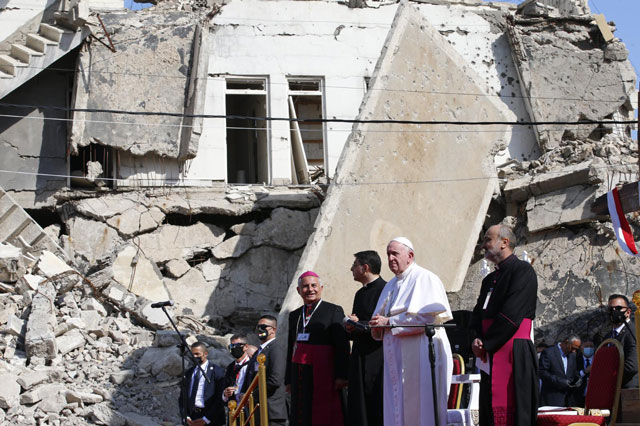
Qaraqosh, Irag | Cindy Wooden-CSN | Amid the rubble and bombed out remains of four churches destroyed by Islamic State militants, Pope Francis paid tribute to Iraqi Christians who endured persecution and even death.
While visiting Mosul and Qaraqosh in northern Iraq March 7, he also urged the Christians to live up to their faith and honor the sacrifice of those who died by promoting peace and reconciliation.
Much of Mosul’s old city center remains in ruins or under reconstruction. And Pope Francis stood in Hosh al-Bieaa, church square, facing some of those ruins: the remains of the Syriac Catholic, Armenian Orthodox, Syriac Orthodox and Chaldean Catholic churches all destroyed between 2014 and 2017.
His message was clear:
“If God is the God of life — for so he is — then it is wrong for us to kill our brothers and sisters in his name.
“If God is the God of peace — for so he is — then it is wrong for us to wage war in his name.
“If God is the God of love — for so he is — then it is wrong for us to hate our brothers and sisters.”
Stories of war
In Mosul, 250 miles north of Baghdad, Pope Francis listened to the stories of Christians forced to flee, the fear many have to return and the encouragement of Muslim neighbors committed to making the city a thriving, multicultural metropolis again.
But he also heard choirs of children singing in welcome, women ululating to honor his arrival and the cheers of young people waving flags.
Father Raid Adel Kallo, pastor of Mosul’s Church of the Annunciation, told the pope that he and many of his people left the city in June 2014; at that point, he said, his parish had 500 families. “The majority have emigrated abroad,” but 70 families have returned. “The rest are afraid to come back.”
The 2003 invasion of Iraq by U.S. and coalition forces battered the city but the biggest, most horrifying blow came in early June 2014 when militants of the Islamic State group launched an offensive. They controlled the city for three years, terrorizing the population, executing hundreds and kidnapping, raping and selling women. They blew up major landmarks, both Muslim and Christian. They destroyed libraries and museums and tens of thousands of lives.
Ruined churches
After the prayer service and a private visit to the ruined churches, Pope Francis took a helicopter about 20 miles Qaraqosh, a majority Christian city that also suffered devastation at the hands of the Islamic State group. Less than half of the city’s inhabitants have returned since the militants were ousted in 2016.
Mounir Jibrahil, a 61-year-old math teacher, said he came back in 2016, but only finished rebuilding his house last year.
“Now it’s safer here,” he said. “It’s great to see the pope; we never expected him to come to Qaraqosh. Maybe that will help to rebuild the country, finally bringing love and peace.”
The largest crowds of the pope’s March 5-8 visit to Iraq lined the streets in Qaraqosh. While security concerns meant leaving the popemobile in Rome and using an armored Mercedes-Benz in the town, the pope had the window down and the driver going slow enough that the police and security officers on foot did not even have to jog.
And, on the eve of International Women’s Day, Pope Francis paid special tribute to Mary — a photo of a decapitated statue of her from Qaraqosh made the news around the world — and to “all the mothers and women of this country, women of courage who continue to give life in spite of wrongs and hurts.”
****
CATHOLIC NEWS SERVICE (CSN)
 The Independent Uganda: You get the Truth we Pay the Price
The Independent Uganda: You get the Truth we Pay the Price



